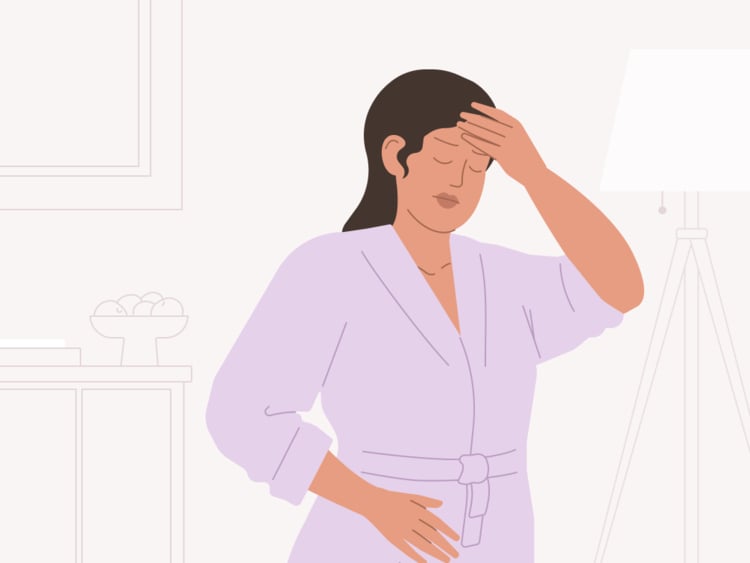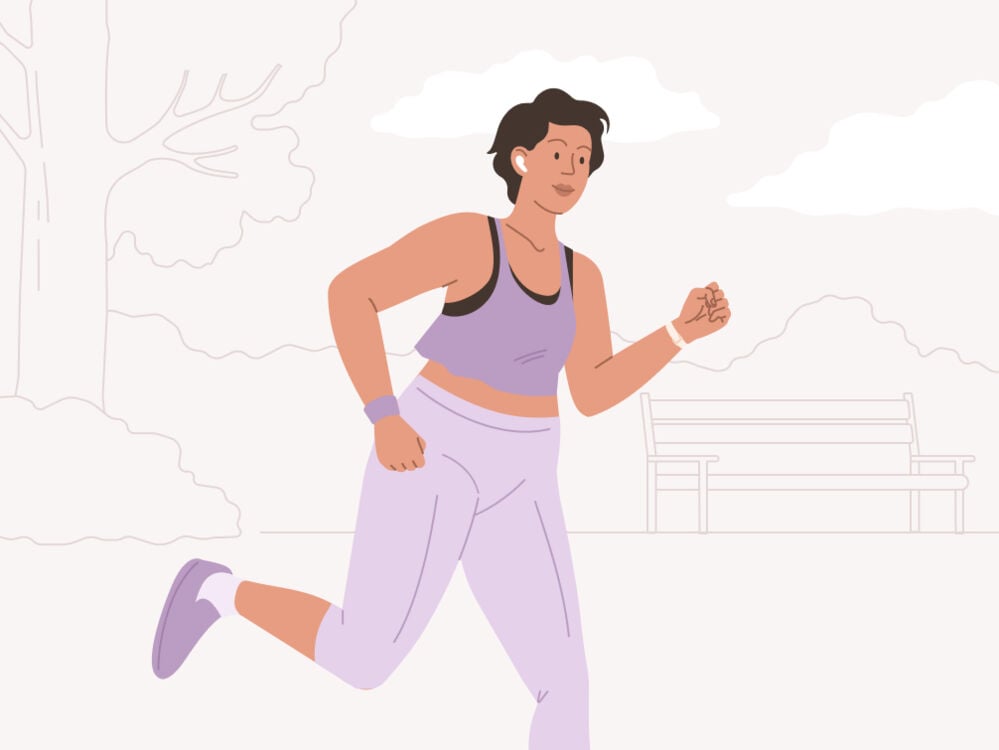What is PMS, and how can you manage the symptoms? Here’s the lowdown on getting your life back on track.
-
Tracking cycle
-
Getting pregnant
-
Pregnancy
-
Help Center
-
Flo for Partners
-
Anonymous Mode
-
Flo app reviews
-
Flo Premium New
-
Secret Chats New
-
Symptom Checker New
-
Your cycle
-
Health 360°
-
Getting pregnant
-
Pregnancy
-
Being a mom
-
LGBTQ+
-
Quizzes
-
Ovulation calculator
-
hCG calculator
-
Pregnancy test calculator
-
Menstrual cycle calculator
-
Period calculator
-
Implantation calculator
-
Pregnancy weeks to months calculator
-
Pregnancy due date calculator
-
IVF and FET due date calculator
-
Due date calculator by ultrasound
-
Medical Affairs
-
Science & Research
-
Pass It On Project New
-
Privacy Portal
-
Press Center
-
Flo Accuracy
-
Careers
-
Contact Us
Premenstrual syndrome (PMS): Everything you need to know


Every piece of content at Flo Health adheres to the highest editorial standards for language, style, and medical accuracy. To learn what we do to deliver the best health and lifestyle insights to you, check out our content review principles.
Hands up if you regularly feel bloated, moody, hungry, tired, or a whole host of other irritating symptoms right before your period? Turns out, there could be a reason for that. Here we explore everything you need to know about premenstrual syndrome (PMS), from symptoms to treatment options.
Key takeaways
- PMS is the umbrella term for the physical and emotional symptoms that can show up before your period.
- Symptoms of PMS vary from person to person, but they can include bloating, food cravings, fatigue, and mood swings.
- PMS symptoms usually start one to two weeks before your period and ease within four days of it starting.
- Exercise, getting enough sleep, eating a balanced diet, and hormonal birth control can all help to manage symptoms of PMS.
Premenstrual syndrome: What is it?
PMS is a group of different symptoms that occur a week or two before your period starts.
These symptoms can vary from person to person and can be physical, emotional, or a combination of both; more on these later.
PMS is often the butt of the joke, and it's become a bit of a stereotype that it makes women and people who menstruate “emotional.” It’s important to challenge this belief because it can trivialize PMS and make it hard for people who are struggling with PMS to feel heard.
If you have periods, it’s important to know the signs of PMS and how to deal with them. Keep reading to learn more.
What causes PMS?
It’s not entirely clear why some people experience PMS, but it’s likely due to the hormonal changes that happen during the menstrual cycle. These changes affect each person differently, so some people may experience more severe symptoms than others. Like many aspects of female health, PMS still isn’t completely understood, and we need more research to understand the exact cause.
How common is PMS?
PMS is pretty common. In fact, around 75% of women experience symptoms of PMS, so if you’re one of them, take some comfort in knowing that you’re definitely not alone.
Take a quiz
Find out what you can do with our Health Assistant
What are the symptoms of premenstrual syndrome?
Good question! There are a wide variety of symptoms of PMS, ranging from physical symptoms to ones that affect you emotionally. It’s worth remembering that everyone experiences PMS differently, so you might have all, or just some, of the following symptoms (this isn’t an exhaustive list).
Physical PMS symptoms
- Headaches
- Cramps
- Tender or sore breasts
- Bloating
- Fatigue
- Breakouts or greasy skin
- Decreased or increased appetite or food cravings
Emotional PMS symptoms
- Feeling sad or anxious
- Having a lack of interest in activities
- Insomnia or needing to nap more often
- Changes in libido
- Trouble concentrating
- Depression
- Irritability
How is PMS diagnosed?
First things first: There’s no specific test for PMS. With this in mind, your doctor will run through the symptoms you experience and when they tend to appear in your menstrual cycle. If you experience at least one symptom that starts within five days of your cycle and goes away within four days of the end of your period, and this occurs for at least three cycles and affects your day-to-day life, then you may be officially diagnosed with PMS.
Living with premenstrual syndrome: What can you expect?
Everyone’s experience with PMS is unique. For some, it’s barely noticeable. For others, it can seriously affect their quality of life. For this reason, there isn’t a one-size-fits-all approach to PMS. You might even find that your own symptoms change from month to month! As we’ve seen, you might feel tired and bloated and notice a few extra pimples during PMS. It might also temporarily impact your mood, how much socializing you feel like doing, and your interest in sex, alongside other symptoms. Logging your experiences in an app like Flo can help you track your PMS symptoms so you feel more prepared for what might come.
The most important thing to remember is that experiencing PMS doesn’t have to completely disrupt your daily life. While it’s normal to feel the need to slow down a bit, if PMS is interfering with your life or causing severe pain, depression, or suicidal thoughts, it’s important to speak to your health care provider as soon as possible. Extreme symptoms could be a sign of premenstrual dysphoric disorder, a severe form of PMS, so it’s always good to seek support and assessment from your doctor.
Tips on how to manage PMS symptoms
Whether you’re experiencing physical or emotional PMS symptoms, there are (thankfully) many things you can do to feel better. If your symptoms are mild to moderate, you might even find that making some lifestyle tweaks could help to relieve them.
- Try to fit some regular aerobic exercise into your schedule. Aim for around 30 minutes a day of brisk walking, running, swimming, or cycling.
- Limit your sugar and caffeine intake, while trying to get more protein into your diet. Meat, fish, eggs, beans, peas, nuts, and seeds are all great sources of protein.
- Try relaxation techniques like meditation, yoga, and breathing exercises to destress.
- Struggling with PMS fatigue? Making sure you’re getting enough sleep can help.
You can also consider taking some vitamin supplements like magnesium, calcium, and vitamin B6. Research has also shown that vitamin E could be beneficial. Finally, some people find that taking hormonal birth control helps make symptoms of PMS more manageable or even go away altogether. Just remember to speak to your health care provider before taking any new supplements or medications.

PMS vs. PMDD
Premenstrual dysphoric disorder (PMDD) is a more severe form of PMS that affects around 3% to 8% of women. The symptoms of PMDD are similar to those of PMS, but they’re so intense that they can make it challenging to work and affect your personal relationships. If you have PMDD, you’re more likely to experience severe emotional symptoms and may have depression, anger, or anxiety. If you think this is the case, then don’t suffer in silence. Treatment options are available, so reach out to your health care provider to discuss next steps.
You can learn more about PMDD here.
When should I see a doctor?
Although it’s common to experience PMS symptoms, you should speak to your health care provider if they’re having an impact on your daily life. You shouldn’t have to suffer through physical and emotional symptoms that make it hard to get through the day.
Other conditions could also be causing your symptoms, so it’s always a good idea to get medical advice. Your health care provider may order additional tests to rule out any other issues and help you find the right treatment.
What questions should I ask?
Here is a list of questions about PMS that you might want to ask your doctor.
- How long should PMS symptoms last?
- Are there any PMS signs or symptoms that I should be worried about?
- How can I manage PMS symptoms? Are there any treatment options?
- Can hormonal contraception make symptoms of PMS easier? Are there any risks?
- What can make PMS symptoms worse?
FAQs
Is PMS worse in your 30s?
Annoyingly, yes. PMS may get worse in your late 30s and 40s. This is because your hormone levels fluctuate in unpredictable ways as your body transitions into perimenopause, the period leading up to menopause.
What makes PMS symptoms worse?
Having an overall unhealthy lifestyle could make PMS symptoms worse, which is why making some tweaks such as getting more exercise and modifying your diet can help to ease the symptoms. It’s also worth noting that research has shown that smokers have more issues with PMS than nonsmokers, so trying to cut back or quit could help.
Who is more prone to PMS?
Some research shows that stress and weight gain can make you more prone to PMS.
Is suffering from PMS for 10 days normal?
PMS symptoms can start as early as two weeks before your period arrives, so it’s possible to have PMS for 10 days straight. If PMS symptoms are getting in the way of your day-to-day life and stopping you from working, studying, or socializing, remember that it’s always a good idea to speak to your health care provider.


Hey, I'm Anique
I started using Flo app to track my period and ovulation because we wanted to have a baby.


The Flo app helped me learn about my body and spot ovulation signs during our conception journey.


I vividly
remember the day
that we switched
Flo into
Pregnancy Mode — it was
such a special
moment.
Real stories, real results
Learn how the Flo app became an amazing cheerleader for us on our conception journey.
References
Bäckström, Torbjörn, et al. “The Role of Hormones and Hormonal Treatments in Premenstrual Syndrome.” CNS Drugs, vol. 17, no. 5, 2003, pp. 325–42, https://doi.org/10.2165/00023210-200317050-00003.
Casper, Robert F. “Patient Education: Premenstrual Syndrome (PMS) and Premenstrual Dysphoric Disorder (PMDD) (Beyond the Basics).” UpToDate, 20 Mar. 2023, www.uptodate.com/contents/premenstrual-syndrome-pms-and-premenstrual-dysphoric-disorder-pmdd-beyond-the-basics.
Dennerstein, Lorraine, et al. “Global Epidemiological Study of Variation of Premenstrual Symptoms with Age and Sociodemographic Factors.” Menopause International, vol. 17, no. 3, Sep. 2011, pp. 96–101, doi.org/10.1258/mi.2011.011028.
Farasati, Negin, et al. “Western Dietary Pattern Is Related to Premenstrual Syndrome: A Case-Control Study.” The British Journal of Nutrition, vol. 114, no. 12, Dec. 2015, pp. 2016–21, doi.org/10.1017/s0007114515003943.
Gao, Mingzhou, et al. “Trends in Research Related to Premenstrual Syndrome and Premenstrual Dysphoric Disorder from 1945 to 2018: A Bibliometric Analysis.” Frontiers in Public Health, vol. 9, Apr. 2021, doi.org/10.3389/fpubh.2021.596128.
“Healthy Eating.” The American College of Obstetricians and Gynecologists, Dec. 2020, www.acog.org/womens-health/faqs/healthy-eating.
Hofmeister, Sabrina, and Seth Bodden. “Premenstrual Syndrome and Premenstrual Dysphoric Disorder.” American Family Physician, vol. 94, no. 3, Aug. 2016, pp. 236–40, www.aafp.org/pubs/afp/issues/2016/0801/p236.html.
“PMS (Premenstrual Syndrome).” NHS, www.nhs.uk/conditions/pre-menstrual-syndrome/. Accessed 7 Sep. 2023.
“Premenstrual Syndrome.” Cleveland Clinic, my.clevelandclinic.org/health/diseases/24288-pms-premenstrual-syndrome. Accessed 7 Sep. 2023.
“Premenstrual Syndrome (PMS).” Johns Hopkins Medicine, www.hopkinsmedicine.org/health/conditions-and-diseases/premenstrual-syndrome-pms. Accessed 7 Sep. 2023.
“Premenstrual Syndrome (PMS).” Mayo Clinic, 25 Feb. 2022, www.mayoclinic.org/diseases-conditions/premenstrual-syndrome/diagnosis-treatment/drc-20376787.
“Premenstrual Syndrome (PMS).” Office on Women’s Health, 22 Feb. 2021, www.womenshealth.gov/menstrual-cycle/premenstrual-syndrome.
“Premenstrual Syndrome (PMS).” The American College of Obstetricians and Gynecologists, Dec. 2021, www.acog.org/womens-health/faqs/premenstrual-syndrome.
Yonkers, Kimberly A., et al. “The Influence of Cyclic Hormonal Contraception on Expression of Premenstrual Syndrome.” Journal of Women’s Health, vol. 26, no. 4, Apr. 2017, pp. 321–28, https://doi.org/10.1089%2Fjwh.2016.5941.




